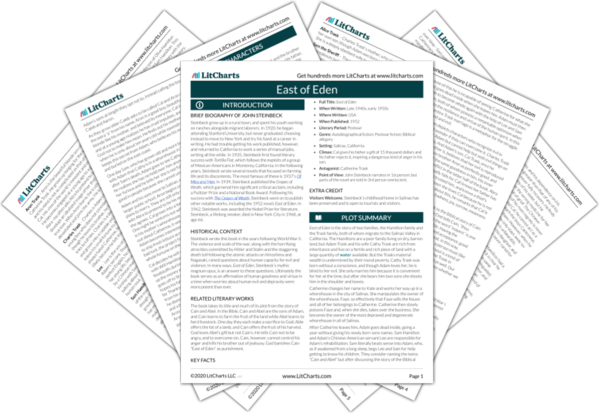East of Eden covers an immense stretch of time—from the American Civil War to World War I. Accordingly, the novel displays a profound interest in the passage of time, the progression of history, and the relentlessness of change. The book opens with, and repeatedly returns to, an almost laborious cataloguing of the differences between seasons. This preoccupation with seasonal transitions, year after year, is a facet of the novel’s investigation of the relentless and yet cyclical nature of time and change.
In the same way that Steinbeck carefully records the physical change of the earth, air and sky over time, he records the changes of the body over time. We learn a great deal about how Sam Hamilton’s body ages—his wrinkled face and silver beard are dwelled upon by the narration at length. Notably Sam and his family can hardly believe that he is even capable of growing old. Time’s effect comes as a kind of shock to them. Adam’s mental sickness following the departure of his wife gets better over time—Sam notes that time is the perfect “tonic” for him. Catherine’s arthritis, in contrast, is a gruesome physical manifestation of time’s passage. She resents the aging and twisting of her face and body so much it inspires a manic kind of anger in her. Thus illnesses (which sometimes worsen and sometimes improve over time), aging, and death play a huge role in this multigenerational epic. They remind the reader of times inevitable passage and of the inescapability of change.
The novel also takes stock of the rapid technological progression and change that took place in the late 19th and early 20th centuries. Steinbeck goes to great lengths to include myriad new technologies. Railroads, cars, planes, refrigeration, drills, windmills, conveyor belts, color photography, and advances in military technologies are all included, all given a kind of history in this book. Technological progress—and the excitement and anxiety surrounding it—also evinces the (often fearsomely rapid) advancing of time.
Steinbeck wrote this novel in the early 1950s. This was a deeply transitional era. Coming out of the Second World War, Americans demonstrated an enthusiasm and optimism for the future, but it was also a time of great nostalgia for a “simpler” past. New technologies were exciting testaments to American ingenuity, but (as in the case of the atom bomb) they could also gesture towards an even more violent future. This sense of instability, this constant question about what the future might hold, pervades this novel. What’s more, Steinbeck’s health was beginning to suffer around the time he wrote East of Eden. He was a lifelong smoker, and would die of heart disease in 1968, just over 15 years after East of Eden was published. The anxiety of the nation with respect to time and change is coded into this novel but so too is the anxiety of the individual; in many ways the book’s discussion of time reflects universal worries and questions about aging, illness, and mortality.
Time ThemeTracker

Time Quotes in East of Eden
They landed with no money, no equipment, no tools, no credit, and particularly with no knowledge of the new country and no technique for using it. I don’t know whether it was a divine stupidity or a great faith that let them do it. Surely such venture is nearly gone from the world
To hell with that rotten century! Let’s get it over and the door closed shut on it! Let’s close it like a book and go on reading! New chapter, new life. A man will have clean hands once we get the lid slammed shut on that stinking century. It’s a fair thing ahead. There’s no rot on this clean new hundred years. It’s not stacked, and any bastard who deals seconds from this new deck of years—why, we’ll crucify him head down over a privy. Oh but strawberries will never taste as good again and the thighs of women have lost their clutch!
I don’t know how it will be in the years to come. There are monstrous changes taking place in the world, forces shaping a future whose face we do not know. Some of these forces seem evil to us, perhaps not in themselves but because their tendency is to eliminate other things we hold good.
The church and the whorehouse arrived in the Far West simultaneously. And each would have been horrified to think it was a different facet of the same thing. But surely they were both intended to accomplish the same thing: the singing, the devotion, the poetry of the churches took a man out of his bleakness for a time, and so did the brothels.
One day Samuel strained his back lifting a bale of hay, and it hurt his feelings more than his back, for he could not imagine a life in which Sam Hamilton was not privileged to lift a bale of hay.
“We are descended from this. This is our father. Some of our guilt is absorbed in our ancestry. What chance did we have? We are the children of our father. It means we aren’t the first.”
“A great and lasting story is about everyone or it will not last.”
All novels, all poetry, are built on the never-ending contest in ourselves of good and evil. And it occurs to me that evil must constantly respawn, while good, while virtue, is immortal.
“I send boys out…I sign my name and they go out. And some will die and some will lie helpless without arms and legs. Not one will come back untorn. Son, do you think I could take a profit on that?...I don’t want the money, Cal. And the lettuce—I don’t think I did that for a profit.”
















